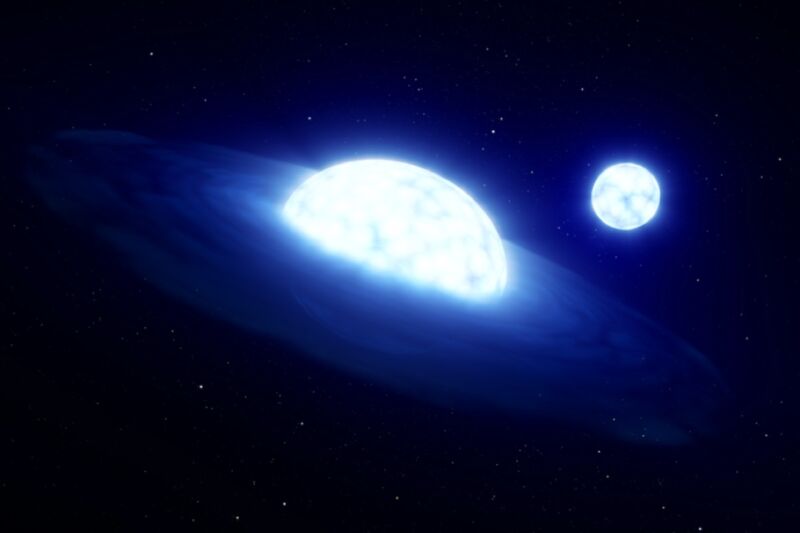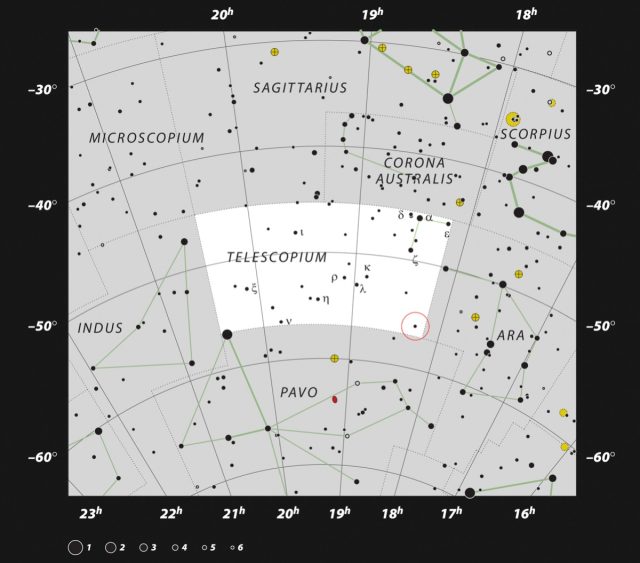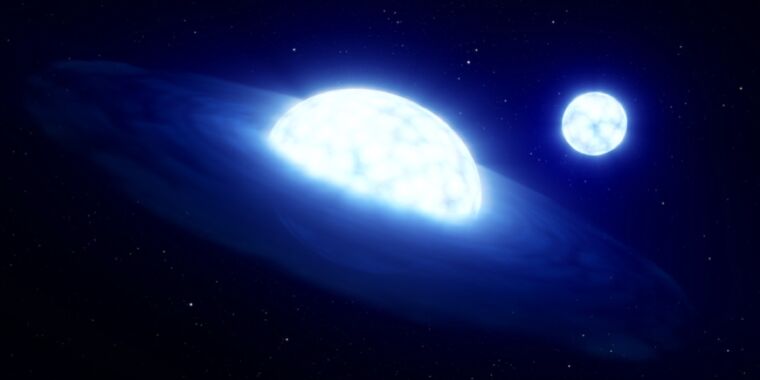
ESO/L. Calçada
Back in 2020, astronomers discovered an unusual star system just 1,000 light years from Earth. However, two different teams disagreed on the nature of the system, which was dubbed HR 6819. One team argued that it was looking at a trinary grouping with two stars orbiting a black hole. The other team thought HR 6819’s properties could just as easily be explained by a two-star system without a black hole.
To resolve the issue, the two groups collaborated on collecting additional observational data. The result: HR 6819 is indeed a binary system with no black hole, according to a new paper published in the journal Astronomy and Astrophysics. But HR 6819 is nonetheless a rarity: astronomers captured the binary system just after one star had stripped its partner of its atmosphere in a process known as “stellar vampirism.”
As we previously reported, scientists think there are far more black holes in the Universe than we have discovered to date—probably hundreds of millions of them, given the age of our Universe. We have discovered so few black holes because, instead of being able to observe them directly, we can only infer their presence by their effect on surrounding matter. A black hole’s gravitational effects can influence the orbits of nearby stars, for example, or infalling matter can form an accretion disk of hot gas rapidly orbiting the black hole, emitting powerful X-rays. Or an unfortunate star will get too close to a black hole and be torn apart for its trouble, with the infalling remnants also accelerating and heating up to emit X-rays into space.
But the majority of black holes are actually quiet and hence very difficult to detect. Astronomers believed that the 2020 discovery of HR 6819 offered useful clues about where at least some of the truly dark black holes might be hiding.
Researchers at the European Space Observatory had been conducting a study of double-star systems, and HR 6819 was included as part of their observational data-gathering since it appeared to be just such a system. But while reviewing their data, the astronomers found evidence of an unexpected third object in the system: a black hole that had previously eluded detection.
In a trinary star system, two of the stars orbit each other as a binary pair, while the third star orbits the pair at a greater distance. This ensures that the system is stable, since if the inner and outer orbits were the same size, one of the stars would eventually be ejected from the system. In the case of HR 6819, one of the two visible stars appeared to be orbiting an invisible object every 40 days, while the other visible star orbited farther away. By studying the orbit of the star in the inner pair, the team inferred the potential black hole’s presence and also calculated its likely mass.

ESO, IAU, and Sky & Telescope
However, a second analysis of the data published that year by other researchers concluded that HR 6819 might actually be a binary system. According to the analysis, the two stars both had 40-day orbits and there was no black hole in the center after all. In that case, one of the stars would have lost a huge chunk of its mass to its partner.
To resolve the issue, the two groups decided to work together, collecting new observational data with the European Space Observatory’s Very Large Telescope (VLT) and Very Large Telescope Interferometer (VLTI). “We agreed that there were two sources of light in the system,” said co-author Thomas Rivinius, an ESO astronomer based in Chile. He was part of the team that suggested back in 2020 that HR 6819 might be a trinary system with a black hole. “So the question was whether they orbit each other closely, as in the stripped-star scenario, or are far apart from each other, as in the black hole scenario.”
The data showed that the latter was the case: the VLT’s higher resolution revealed that the two stars were separated by just one-third the distance between the Earth and the Sun. There was no bright companion star with a wider orbit and no black hole.
“Our best interpretation so far is that we caught this binary system in a moment shortly after one of the stars had sucked the atmosphere off its companion star, said co-author Julia Bodensteiner, an ESO fellow in Germany. “This is a common phenomenon in close binary systems, sometimes referred to as ‘stellar vampirism‘ in the press. While the donor star was stripped of some of its material, the recipient star began to spin more rapidly.”
An example of stellar vampirism is an exciting finding in its own right, since that phase of stellar evolution is relatively short and hence very difficult to detect. Further study of HR 6819 could shed light on how stellar vampirism can affect the evolution of massive stars. And while the missing black hole is a disappointment, Rivinius remains confident that astronomers will eventually discover the tens to hundreds of millions of black holes they suspect are lurking in our galaxy.
DOI: Astronomy and Astrophysics, 2022. 10.1051/0004-6361/202143004 (About DOIs).
One team found a black hole, the other challenged its results. This is the story of how they got together to find out who was right.








